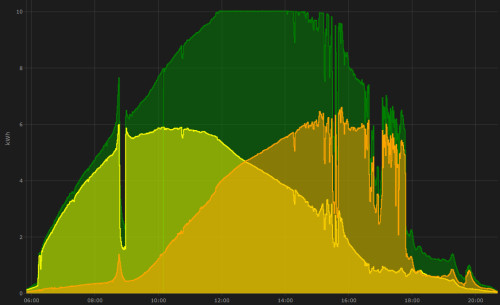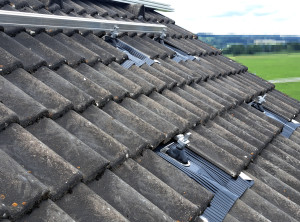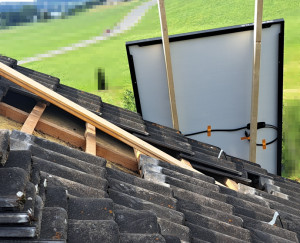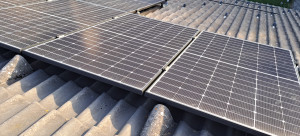PV - Considerations - Planning - Implementation
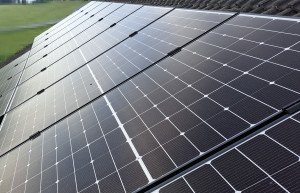
Compared to 2023, the module prices are now much cheaper and the waiting time for implementation much shorter. This was actually foreseeable, but I - like many others - lost my nerve in 2023 and installed the PV system on the roof myself. In hindsight, I was able to compensate for the higher material price with my own work and the more expensive - but more lucrative - subsidy. And: I can still feed the entire output into the grid before the nearby transformer station is extended, even if the remuneration is no longer very high.
Balcony power plant vs. PV system
The low costs and simple and unbureaucratic installation of a balcony power plant lead in most cases to a quick amortization. The calculation for a PV system is somewhat more complicated. How quickly a PV system pays for itself depends first and foremost on your own electricity consumption and the development of the electricity price. The heating system can certainly also have a positive effect on the bill if it is operated with electricity, as in the case of a heat pump. The components installed also play components used, the level of personal contribution required for implementation and, last but not least, the level of funding.
What is needed for a PV system?
- Inverter
- PV panels
- Mounting material and cables
- For balcony power plants up to 800 watts
- Registration with the electricity provider
- Schuko socket outlet
- Systems larger than 800 watts additional:
- Own circuit breaker connection in the main distribution cabinet (FI, LS)
- Separate cabling from the main distribution cabinet to the inverter
- Surge arrester: Between PV panels and inverter, as well as on the AC side in the main distribution cabinet
- and at least for Austria:
- Notification to and acceptance by the energy provider
- Feed-in authorization and
- a contract with an energy consumer when selling the surplus energy
Lessens Learned
Multiple strings: Panels in series ...
When using multiple panels, they are usually connected together in so-called strings in series, similar to a series connection of batteries. Multiple batteries or in this case panels in series increase the voltage while the current remains the same. Anyone who has studied a little electrical engineering will know that it is not relevant in terms of the wire cross-section in a series connection how many panels are connected together in a string. For the supply lines to the panels, a 6mm² cable is usually used, the panels themselves are usually equipped with a 4mm² cable.
South or alternatively East-West orientation?
The PV panels of a string should be aligned in the same angle towards the sun. In Central Europe, these provide the highest yield with an approx. 30° orientation to the south. In total, two roof surfaces with an east-west orientation provide somewhat less power, but better distributed over the entire day. To create two strings with different orientations, most inverters have two MPP trackers that work independently, similar to using two separate inverters.
Pi times thumb dimensioning: Peak power: 1 kWp = approx. 1000 kWh / year
For rough dimensioning, it is common practice in Central Europe to use the annual electricity consumption / 1000 as a basis for dimensioning the system. As a concrete example, a 10kWp system would produce approximately 10,000 kWh (10MWh) of electricity in one year. The problem with this calculation is the timing: in summer there is usually a surplus of electricity produced during the day, but at night or in winter there is not enough power. On the one hand, because the days are shorter in winter, on the other hand, because the electricity consumption is predominantly higher in winter: especially when a heat pump or other electricity heating is in use. An appropriately sized battery storage counteracts this and significantly increases self-consumption, as the excess energy collected during the day can be collected and consumed at night.
Peak power: rather rare?
Through my tests with a balcony power plant it became clear to me that the maximum possible peak power is very rarely reached: Especially when the angle to the sun does not fit perfectly, or it is too hot. Since the roof of my house is not south-facing, but east-west with a roof pitch of 33°, the respective peak power of the east and west strings is never reached at the same time.
East-West orientation: More module power than the inverter can handle?
Assuming that the annual power consumption of my household - mind you including heating - is 10-14MW, this value serves as a basis for rough sizing. At the risk of the inverter reaching its maximum now and then, based on the previously mentioned Pi times thumb calculation I have planned 10 kWp for the inverter and 15kWp for the PV panels: 7.5 kWp for east and 7.5kWp for west. At this point, of course, a look should be taken at the data sheet of the inverter, especially at the maximum possible DC power. This enables the setup to produce power from dawn to dusk when the sun is shining, for as long as possible and as often as possible close to the 10kWp. The 10kWp is also the bottleneck power, that is, the power that is limited by the least powerful part, in this case the inverter:
Here is an example of a sunny day in July: the two halves of the roof, east and west, alternate production. When it is very cloudy, the two sides of the roof produce less, but then about the same amount, which can be seen from about 18:00: In the case of heavy cloud cover, it is the available PV area that counts more and less its orientation.
Legend: green: total output | yellow: output roof side east | orange: output roof side west
Because I have dimensioned the module output is larger than the inverter can handle, it occasionally reaches its limit in bright sunshine and during the midday hours, especially in summer. On closer inspection, the behavior is not too bad, especially as the possible yield above 10kWp is very limited in terms of time and the peak power above 10kW contributes very little to the total yield in percentage terms. I also achieve a current household consumption of over 10kW in practice: not even if several power-hungry appliances such as the heat pump, oven, washing machine or dryer are running at the same time. If I compare the additional costs for a larger or second inverter with the possible additional yield, I don't think I'm too far wrong with the dimensioning of the module output. Not least because the additional module output in in terms of self-consumption has a very positive effect in that the yield is maximized - especially in less than optimal light conditions - when every kilowatt counts.
The choice of PV panels: voltage vs. current
The selection of the inverter should definitely be coordinated with the voltage and current values of the PV panels, otherwise they may not be able to deliver the full power or, in the worst case, overload the inverter, causing it to refuse service. Particularly, cold temperatures in winter could push the system to its limits. I will explain why in the following article: The selection of PV panels: voltage vs. current
Do I need power optimizers for partial shading?
As an alternative to using power optimizers, today's inverters and the bypass diodes installed in the PV modules can compensate for slight shading situations. I have considered exactly how this could work in a separate article: MPP and the Shade: Power Optimizers vs Dynamic Peak vs Microinverters.
Course of the sun: Positioning
When positioning the PV panels, you should also take a look at the course of the sun: The shadow calculation in particular can show the influence of neighboring houses or obstacles for different times and seasons: www.sonnenverlauf.de/
The choice of the inverter
To be able to increase self-consumption with a battery, I primarily looked for hybrid inverters. The Austrian"Inverter List TOR Generator Type A" limits the choice of approved hybrid inverters for 10kWP to a few suppliers. Since my house roof is not shaded during the day, the consideration of whether the use of power optimizers makes sense is done for me. Also the use of micro-inverters is not really worthwhile in my case, because a central inverter is much cheaper and better suited for battery operation. Finally, I tended between the Huawei SUN2000 10KTL and the Fronius Gen24 10kW, the latter was more sympathetic to me from the beginning, probably also because Fronius is an Austrian manufacturer. The easy possibility to implement an emergency power socket is one of the main advantages of the Gen24, against it spoke long its price and availability. In the meantime, however, the situation has calmed down somewhat.
Conversion - expanding the distribution cabinet
If the distribution cabinet corresponds to the state of the art, the PV system usually only requires an additional RCD and circuit breaker. Since most inverters already have a type B RCD installed, a cheaper type A RCD is usually sufficient in the meter cabinet. The details can be found in the Fronius Gen24 operating manual. The cable length from the meter cabinet to the inverter should not exceed 10 meters, at least in Austria, because otherwise the surge protection installed in the pre-meter field is not sufficient and an additional surge arrester must be installed.
I still had a separate electricity meter in use for the heat pump, which is not ideal for the operation of a PV system with excess feed, because the self-produced electricity can be better used with only one meter. For this reason, I shut down the second meter at the same time as commissioning the PV system. Details on the conversion, see: Fronius Gen24 Commissioning. I was also able to significantly increase my own consumption by installing relays to control the heating, see: Control heating with Home Assistant.
Wiring from the inverter to the PV panels.
If no lightning conductor is in use, it is sufficient In Austria to install a junction box (GAK) with contained type 2 surge arrester as close as possible to the roof entrance. The DC cables of the PV strings are connected with 4 mm² or better 6mm² cable to the GAK and from the GAK it goes with 2 x 6 mm² cable per string to the inverter. At this point, 10 meters should not be exceeded, otherwise a surge arrester must be installed again in or before the inverter. In addition, according to R11-1, the DC cables in Austria must be routed in a solid masonry or / and in a metal pipe. The metal pipe then leads up to the roof outlet to the PV panels.
Mounting the panels
The roof of my house is a gable roof with plain tiles. To avoid cutting out the tiles and risking tile breakage in the long run, I decided to use SL-Rack Alpha replacement tiles. The installation itself is shown in numerous YouTube videos and should be able to be done in a few days. For the planning incl. statics and ready material list supports the SL-Rack Pro Tool.
Probably the biggest challenge was then to get the PV panels on the roof. Since my modules with 19.7 kg are also unwieldy, but still belong to the lighter and smaller models, I was able to pull them up over the adjacent garage by hand.
After mounting, I attached the cables of the PV panels to the rails with cable ties so that they do not touch the roof and do not run the risk of damage over time.
Conclusion
Depending on the circumstances, your own skills and possibilities, you can do quite a lot yourself when implementing a PV system. For the rough dimensioning of my system, in addition to the rule of thumb: kWp * 1000, I included the roof orientation: east-west and set the module output correspondingly higher, as well as checking the voltage and current values of the PV panels and the inverter.
 ({{pro_count}})
({{pro_count}})
{{percentage}} % positive
 ({{con_count}})
({{con_count}})
